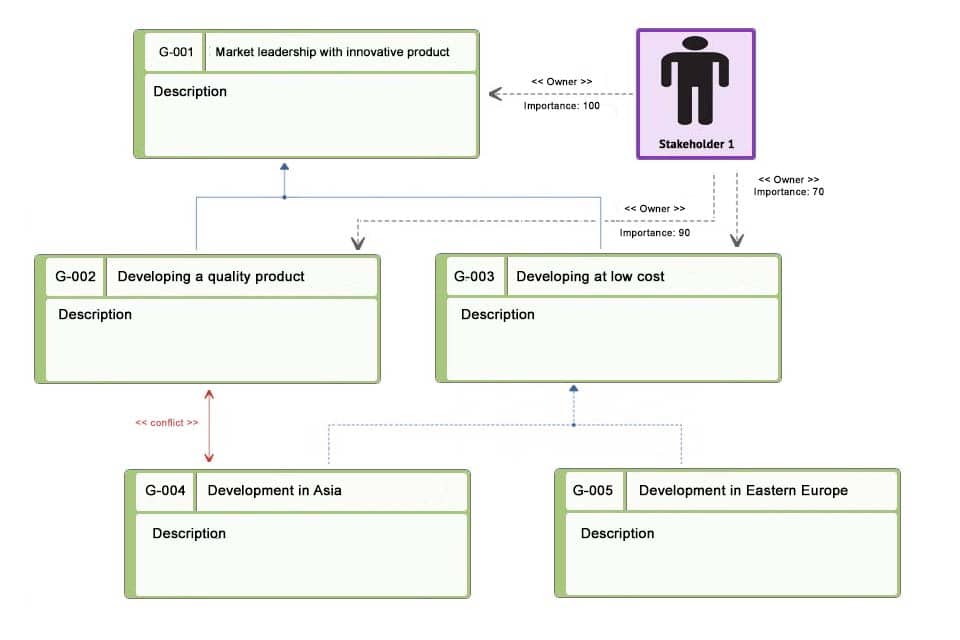What is a Product Goal?
Table of Contents: Definition – Differences between market goal, product goal and product vision – Product goal in Scrum – Advantages – Notes
Smartpedia: Product goals are qualitative objectives of product development, i.e. they determine, among other things, the type and quality of products.
Product Goal Definition
Ideally, a product or service has unique features to excite and win customers or users. At the same time, such features facilitate differentiation from the competition. However, the realisation of features is not identical with the achievement of product goals.
Product goals are qualitative objectives that relate to the type and functional, technical and ecological quality of the products, to the product range and to the product quantity. They are an essential aspect in the definition of a product strategy and, in contrast to market goals, work in the direction of the manufacturing company and not in the direction of the market. Together with market goals, product goals are also called performance goals.
What are the differences between market goal, product goal and product vision?
In the literature and also in corporate reality, it happens time and again that three terms are mixed up:
- market goal,
- product goal and
- product vision.
Since the boundaries of these terms are fluid, it is important for organisations to develop a common understanding and agree on a common use of the terms.
A market goal of a product (or service) addresses its quantitative impact in a market. Typical market objectives are:
- market position (e.g. innovator, early adopter, early majority, late majority, laggards),
- market power (e.g. monopoly, oligopoly, polypoly, monopsony) and
- market share (e.g. in a sub-market or the total market in terms of quantity or value).
For market goals it is essential to “understand” a market with its market participants – i.e. customers and users, suppliers, competitors, legislators, associations, etc. – and their needs, and to segment it geographically, demographically, socio-psychologically and by behaviour. For the determination of market shares, knowledge of market capacity (theoretical size without taking purchasing power into account), market potential (the optimal sales volume), market volume (effectively sold quantity of a product) and the degree of market saturation are important. In addition, there are considerations about the product life cycle and a corresponding market strategy.
Of course, products and services are also developed to meet the needs of a defined target audience. However, the product goals do not focus on these needs but on the product or service itself. It is not about market segments and market shares. Product goals focus on:
- the type of product (e.g. mass, serial, niche, individual and by-product, or also complementary or substitute product),
- the quality in the sense of conformity of the performance with the demands of the customers, producers or suppliers and with regard to functional, technical, ecological aspects,
- the assortment (shallow, deep, wide or narrow),
- as well as the production quantity and production capacity (context-dependent on the type of product and the available capital or personnel).
Furthermore, product management addresses existing product goals through measures such as product innovations, variations, differentiation, diversification and elimination.
And what is a product vision? A product vision is a vivid blueprint for the future of a product, on which the product strategy is based. Ideally, it references the company’s vision and should be developed jointly within the company with commitment and communicated with conviction. In addition, it should contain an external reference and provide orientation for those involved in the development.
In many companies, schematic representations are used to determine the product vision.¹ It is recommended, for example, to determine the following aspects:
- What is the motivation for creating the product and what positive change should it bring about?
- Which market or market segment does the product address and who are the target customers?
- What problem does the product solve and what benefits does it offer?
- What is the product, what makes it different and how can the product be developed?
- How will the product benefit the company and does it fit with the company’s goals?
- Who are the main competitors and what are their strengths and weaknesses?
- How can the product be monetised?
- What are the main cost drivers for market development, sales and service of the product?
- How and through which channels will the product be marketed and sold?
These questions are certainly very useful in practice, but beware: they address aspects that are also considered when defining the market and product goals. So how can product vision, market goal and product goal be differentiated in practice? The answer is:
- temporally,
- through the possible use of key figures and
- indirectly by benchmarking.
What would you create first? Ideally, first a rough orientation, a North Star as an orientation in the distance. This orientation is the product vision. It answers the central question: “What is the motivation for creating the product and what positive change should it bring about?” Or put another way, “Why and for what purpose is the product being developed?” This is followed by product goals and market goals.
How do key figures help? Expressing a “why” and “what for” in numbers is probably only possible indirectly. However, it is relatively easy to define key figures for market goals – e.g. for targeted market shares – and also partly for product goals – e.g. for product quantity.
And how does benchmarking help? By looking at various statements from global players:
- Google: “Our mission: to organise the world’s information and make it universally accessible and usable”.²
- IBM: “To lead in the creation, development and manufacture of the industry’s most advanced information technologies, including computer systems, software, networking systems, storage devices and microelectronics”.³
Such statements or corporate visions are very broad (and promotional), but for this very reason they provide orientation. Among other things, for the company’s internal product development and thus also for the definition of a product vision and the following performance goals.
The Product Goal in Scrum
The Scrum Guide 2020, which defines Scrum with its rules of the game, offers several innovations, including a so-called product goal. As an equivalent to the sprint goal, which sets the scope for the sprint backlog and the sprint, the product goal determines the scope for the product backlog.
The product goal is understood as an answer to a “why”: “Why are we doing all of this work”? And thus it provides a direction for the Scrum team and stakeholders, it provides a context and a purpose.
Here is what the Scrum Guide says about the product goal:
- It is the Product Owner’s responsibility to develop and explicitly communicate it, with support from the Scrum Master in finding techniques to define it effectively.
- It represents the long-term goal for the Scrum team to commit to achieving. In other words, it is a commitment.
- It should be made transparent in the product backlog.
- It must be measurable, although the measurement is context-dependent.
- An increment is a concrete intermediate goal on the way to the product goal.
- All the work necessary to achieve it takes place in the sprints.
- In the sprint review, the Scrum team presents the results of its work and the progress towards the product goal is discussed.
Basically, it can also be stated that there is an interaction between product goal and product backlog. On the one hand, it helps to develop the backlog, but on the other hand, the backlog can also have an impact on the product goal, because it can change in the course of a development.
And what is the difference between a Product Goal and a Vision? There is no statement on this in the Scrum Guide. While the 2017 version of the Scrum Guide still said: “The increment is a step towards a vision or a goal.” the current version does not contain the word “vision” even once. Instead there is a nice wording: “… The Scrum framework is purposefully incomplete, only defining the parts required to implement Scrum theory”. Ergo: The difference is not important for the authors. And this brings us back to the statement: “Since the boundaries of these terms are fluid, it is important for organisations to develop a common understanding and agree on a common use of the terms”.
Advantages of product goals
There are a number of advantages to working with product goals:
- They provide orientation for all parties involved as to the (basic) direction in which a product or service should be developed.
- They help to define backlog items or requirements and, if necessary, also provide a boundary for determining the system context.
- They support the elimination of backlog items or requirements that do not contribute to the achievement of the product goal.
- Through transparent documentation, they ideally prevent scope creep, i.e. the creeping shifting of goals.
- They can be visualised in a goal diagram and developed jointly within an organisation.
- They can be used as a tool independent of the lived approach.
- They facilitate the use of prioritisation methods within product development.
- …
Impulse to discuss
When the Scrum Guide calls for the product goal to be formulated in measurable terms, is it mixing market and product goals?
Notes:
[1] The Product Vision Board Extended by Roman Pichler
[2] Googles Mission Statement
[3] IBMs Mission Statement
When defining product goals, it is of course important to keep an eye on legal requirements and technological inventions, as well as social, economic and ecological changes.
Here you will find an assessment of product goal vs. product vision in Scrum (in German).
Here you will find an article on the three most common misconceptions about vision.
If you like the article or would like to discuss it, please feel free to share it in your network. And if you have any comments, please do not hesitate to send us a message.
And here you will find additional information from our Smartpedia section:



